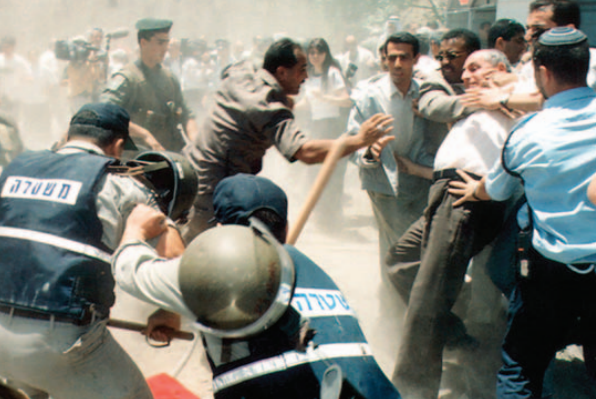The Revolution of the tunnel
A popular Palestinian donation called the" gift of the tunnel " broke out on September 25, 1996 in protest against the digging and opening of the western tunnel under the blessed Al-Aqsa Mosque by the Israeli occupation authorities. All groups of the Palestinian people have united to confront the occupying forces in various areas of the West Bank and the Gaza Strip.
After occupying the rest of Jerusalem in 1967, the Israeli occupation began by demolishing the AL-Maghriba neighborhood located southwest of the Al-Aqsa Mosque, and then began digging under the Western Portico of the Al-Aqsa Mosque until it created a large tunnel with a length of about 330 meters.
The opening of that tunnel by order of Israeli Prime Minister Benjamin Netanyahu aroused the anger of the Palestinians, who all united to confront the occupier, as violent confrontations broke out between Palestinian youths and the occupation forces and spread from Northern to southern Palestine.
The minarets of the city of Jerusalem also started immediately after the opening of the tunnel door with a call to confront this attack, and the people of the city spread on the streets and shouts of disapproval came from their throats, and the occupation forces prevented them from reaching the tunnel site, where the finishing touches were being put to install the iron door that leads to an entrance connecting the wall of Al-Buraq with the gate of Al-ghawanmeh, one of the doors of the Al-Aqsa Mosque.
The confrontations included armed clashes between the security services of the Palestinian Authority and the occupation forces in some Palestinian areas, the most violent of which was the siege of more than 40 Israeli soldiers inside the Joseph shrine east of the city of Nablus, freeing the shrine from occupation control and raising the call to prayer again inside it after decades of occupation control.
A popular Palestinian donation called the" gift of the tunnel " broke out on September 25, 1996 in protest against the digging and opening of the western tunnel under the blessed Al-Aqsa Mosque by the Israeli occupation authorities. All groups of the Palestinian people have united to confront the occupying forces in various areas of the West Bank and the Gaza Strip.
After occupying the rest of Jerusalem in 1967, the Israeli occupation began by demolishing the AL-Maghriba neighborhood located southwest of the Al-Aqsa Mosque, and then began digging under the Western Portico of the Al-Aqsa Mosque until it created a large tunnel with a length of about 330 meters.
The opening of that tunnel by order of Israeli Prime Minister Benjamin Netanyahu aroused the anger of the Palestinians, who all united to confront the occupier, as violent confrontations broke out between Palestinian youths and the occupation forces and spread from Northern to southern Palestine.
The minarets of the city of Jerusalem also started immediately after the opening of the tunnel door with a call to confront this attack, and the people of the city spread on the streets and shouts of disapproval came from their throats, and the occupation forces prevented them from reaching the tunnel site, where the finishing touches were being put to install the iron door that leads to an entrance connecting the wall of Al-Buraq with the gate of Al-ghawanmeh, one of the doors of the Al-Aqsa Mosque.
The confrontations included armed clashes between the security services of the Palestinian Authority and the occupation forces in some Palestinian areas, the most violent of which was the siege of more than 40 Israeli soldiers inside the Joseph shrine east of the city of Nablus, freeing the shrine from occupation control and raising the call to prayer again inside it after decades of occupation control.
The Palestinian donation lasted for six months, during which one hundred Palestinian martyrs were martyred and 1,600 others were injured in various ways.
Despite the peaceful nature of the Palestinian demonstrations, the occupation forces confronted the protesters over the opening of the tunnel and the demonstrations with heavy rubber bullets, and used helicopters and tanks in addition to the settlers ' participation in shooting at Palestinian citizens.
The occupation forces also evacuated Al-Aqsa squares and closed all its doors immediately after the Palestinian uprising in support of their holy sites.
The Palestinian leadership, for its part, acted at various levels at the invitation of the late President Yasser Arafat, who sent letters to the president of the United States of America at the time, Bill Clinton, the late King Hussein of Jordan, and former Turkish President Suleyman Demirel, and put them in the form of the new aggression.
The Supreme Islamic Commission, the deputies of Jerusalem and representatives of the national forces in the city also held an emergency meeting at the Al-Aqsa mosque, condemned the plot and called for a commercial strike and to gather at Bab al-Amud, hours after the opening of the tunnel.
At the international level, the United Nations Educational, Scientific and cultural organization (UNESCO) condemned the digging of the tunnel at the time, as Israel is an occupying entity that cannot carry out archaeological excavations in the city, according to international law.
The tunnel
The Israeli occupation forces started excavations in the western tunnel in 1970, stopped in 1974, and resumed in 1975. The excavation of the tunnel began by order of a religious institution affiliated with the Israeli Ministry of religions, and then the excavation was taken over by a group of archaeologists because of the international objection that the excavation was for a religious purpose.
In 1987, the occupation announced the discovery of a water canal previously discovered by German general Konrad Cech with a length of eighty meters, and the occupation tried to complete the excavations to the Bab al-ghawanmeh Junction and connect the tunnel to the water canal, in 1988, the Jerusalemites confronted him.
The western tunnel passes under a number of archaeological Islamic schools located in the western corridor of the Al-Aqsa Mosque, such as the tanzian school, the ashrafiyya school, the municipal school, the gohariya school and the manjaki school, as well as passes under the chain door and the Sakina door, and under the door of purgatory and Rabat Kurd, and below the qaytbay Avenue, which is located to the east of the western corridor.
According to the director of Tourism and antiquities at the Islamic Endowments Department in Jerusalem, Yusuf al-Natsha, the heights of the tunnel vary from region to region, depending on the topography of the land through which it passes, where in some areas it rises only two meters, while in others it reaches 25 meters.
The digging of the tunnel led to the perforation of a number of water wells below the Western Portico of the Al-Aqsa Mosque, such as the well of the tanzian school, which was completely punctured and emptied of its water, as well as the well of the Ottoman school, which was poured with concrete, in addition to the well of the qaytbay well, the well of Rabat al-Kurd and the manjaki school, as revealed by the director of the Manuscripts Center Radwan AMR to Al Jazeera net.
The construction of the tunnel also caused major cracks in the buildings of the western corridor, where the walls of schools disintegrated from each other, and the stairs of the Islamic Endowments Department collapsed, in addition to a collapse in the qaytbay Avenue area, and the foundations of 16 Islamic teachers were abandoned.




